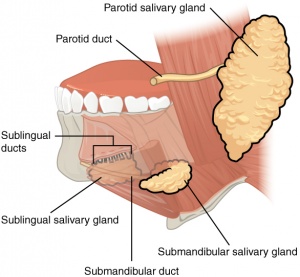Dry Mouth: Difference between revisions
Wendy Walker (talk | contribs) No edit summary |
Wendy Walker (talk | contribs) No edit summary |
||
| Line 49: | Line 49: | ||
== Advice == | == Advice == | ||
Sip water frequently throughout the day - although this is not the same consistency as saliva, it does temporarily help relieve the symptoms<br>Avoid or reduce consumption of caffeine, particularly in coca cola drinks or strong coffee, as these tend to increase mouth dryness<br>Reduction of alcohol consumption is also useful<br>Stopping or reducing smoking is very helpful<br>If struggling to chew foods, choose meals with sauces or gravy<br>Avoid mouthwashes containing menthol, alcohol or foaming agents as these ingredients all cause further reduction in saliva<br> | |||
== Resources<br> == | == Resources<br> == | ||
Revision as of 23:11, 15 November 2015
Original Editor - Your name will be added here if you created the original content for this page.
Lead Editors - Wendy Walker and Tarina van der Stockt
Introduction[edit | edit source]
The medical term for dry mouth is Xerostomia, which is described as being "the subjective feeling of oral dryness, which is often (but not always) associated with hypofunction of the salivary glands".
Signs & Symptoms[edit | edit source]
- sensation of dryness/stickiness in the mouth
- burning sensation in the mouth
- tongue “sticking” causing difficulty in speaking
- difficulty moving food in mouth when eating, especially dry food such as bread
- increased sores/mouth ulcers
- dry, sore and cracked lips
Anatomy
[edit | edit source]
This image shows the 3 main salivary glands.
The Sublingual and Submandibular glands are supplied by the Facial Nerve (7th Cranial Nerve); the Parotid gland is supplied by the Glossopharyngeal Nerve (9th Cranial Nerve).
In addition to these 3, there are more than 800 minor salivary glands spread out throughout the oral mucosa. These minor gsalivary glands are supplied by the Facial Nerve.
It is worth noting that in the region of 65-70% of saliva in the mouth is produced by the submandibular glands, even though as you can clearly see in the image, they are much smaller than the parotid glands.
Causes[edit | edit source]
- Age: dry mouth becomes more common with age
- Facial Palsy: in cases of facial palsy, dry mouth can occur as two of the three main salivary glands receive their parasympathetic nerve supply from the facial nerve: the sublingual and glossopharyngeal glands. (The parotid gland is not innervated by the facial nerve, so is unaffected.)
- Medications: some commonly prescribed medications (particularly those used for control of high blood pressure and treatment of depression)can cause dry mouth, so check the information leaflet to see if this is one of the side effects
- Medical conditions: there are a number of medical conditions which cause dry mouth, with diabetes, and Sjorgren’s Syndrome being two of the most common
- Other treatment: radiotherapy treatment to the head or neck
Advice[edit | edit source]
Sip water frequently throughout the day - although this is not the same consistency as saliva, it does temporarily help relieve the symptoms
Avoid or reduce consumption of caffeine, particularly in coca cola drinks or strong coffee, as these tend to increase mouth dryness
Reduction of alcohol consumption is also useful
Stopping or reducing smoking is very helpful
If struggling to chew foods, choose meals with sauces or gravy
Avoid mouthwashes containing menthol, alcohol or foaming agents as these ingredients all cause further reduction in saliva







